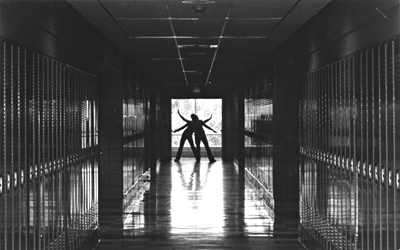All Nonfiction
- Bullying
- Books
- Academic
- Author Interviews
- Celebrity interviews
- College Articles
- College Essays
- Educator of the Year
- Heroes
- Interviews
- Memoir
- Personal Experience
- Sports
- Travel & Culture
All Opinions
- Bullying
- Current Events / Politics
- Discrimination
- Drugs / Alcohol / Smoking
- Entertainment / Celebrities
- Environment
- Love / Relationships
- Movies / Music / TV
- Pop Culture / Trends
- School / College
- Social Issues / Civics
- Spirituality / Religion
- Sports / Hobbies
All Hot Topics
- Bullying
- Community Service
- Environment
- Health
- Letters to the Editor
- Pride & Prejudice
- What Matters
- Back
Summer Guide
- Program Links
- Program Reviews
- Back
College Guide
- College Links
- College Reviews
- College Essays
- College Articles
- Back
What's Broken MAG
T
he Marjory Stoneman Douglas High School shooting was painful to see, and it terrifies me because that could happen to anybody anywhere. It seems that all it takes to get a gun and go kill people is money. We have to fix this problem. We have to march, share our voices, and make a difference. When we do it, we need to listen to the students of color and make sure that their voices are the loudest.
It was important for Naomi Wadler and other students of color to speak at the March For Our Lives rally because black and brown kids die every day and there isn’t a march for them. Standing in front of thousands of people, Naomi said, “For far too long, these names, these black girls and women have been just numbers. I’m here to say ‘Never again’ for those girls too. I’m here to say that everyone should value those girls too.” Gun violence is much bigger than the Stoneman Douglas school shooting. Black and brown teens, kids, and adults are shot every day because of fear, racism, and negative assumptions. The fact that the police are more likely to shoot a black man with a cell phone outside of his own house than a white man with a gun disgusts me. Naomi also pointed out that, “Those stories don’t even lead on the evening news.” The stories of black and brown kids are ignored and passed off as not as important. But when Naomi talked about them, she broke the internet! Naomi said what she believed in front of hundreds of thousands of people. Most adults would have passed out doing that.
The students of color at Marjory Stoneman Douglas High would rather not have more cops on campus because they feel that police will try to hurt them or get them in trouble because of their skin color. In the press conference that black students from Stoneman Douglas held, 17-year-old Kai Koerber said he was afraid that cops working at the school would treat him and other students of color as “potential criminals.”
Law enforcement is supposed to keep us safe, but people are often assumed to be criminals based on the color of their skin. If the police arrest high schoolers, they will be giving them a criminal record that makes it more likely that the arrestee will actually commit a misdemeanor later in life. According to a study by MIT economist Joseph Doyle, “40 per cent of kids who went into juvenile detention ended up in prison by the age of 25.” Some people say if you don’t do anything wrong, the police won’t bother you. But students believe the police will find any sort of reason. When students start to feel uncomfortable, they act more on edge and are more easily provoked. The police are bigger than you and they have got the law on their side; they can do just about anything. Cops in schools can escalate a disagreement into an all-out fight.
This issue is personal because I’m a middle school student of color and I want to feel safe without the presence of police officers watching my every move. If I’m going to feel safe, I don’t want armed officers on my campus at all. Kai Koerber pointed out that cops have a history of treating people of color like potential criminals without proof, evidence and rationality; they also escalate disagreements to the point where they use physical force to resolve conflict. Naomi said the deaths of kids of color have been long neglected, and she’s right. While we are fighting for gun laws to change, we need to focus our attention on all of the shootings, not just the white kids. We need to listen to the kids of color and get their opinion before we call in the cops.

Similar Articles
JOIN THE DISCUSSION
This article has 0 comments.

We need to make a change to do what is right and stop gun violence